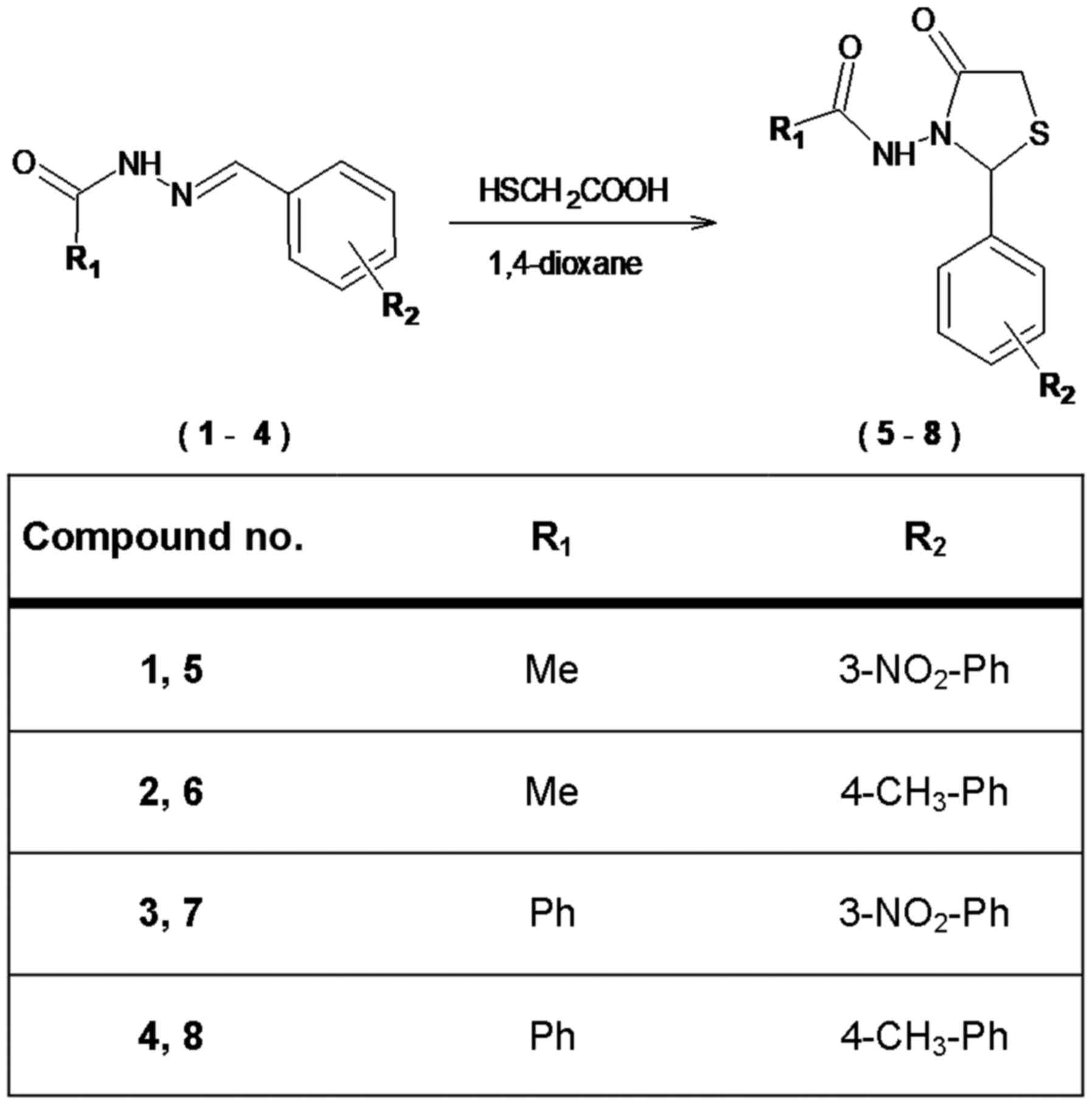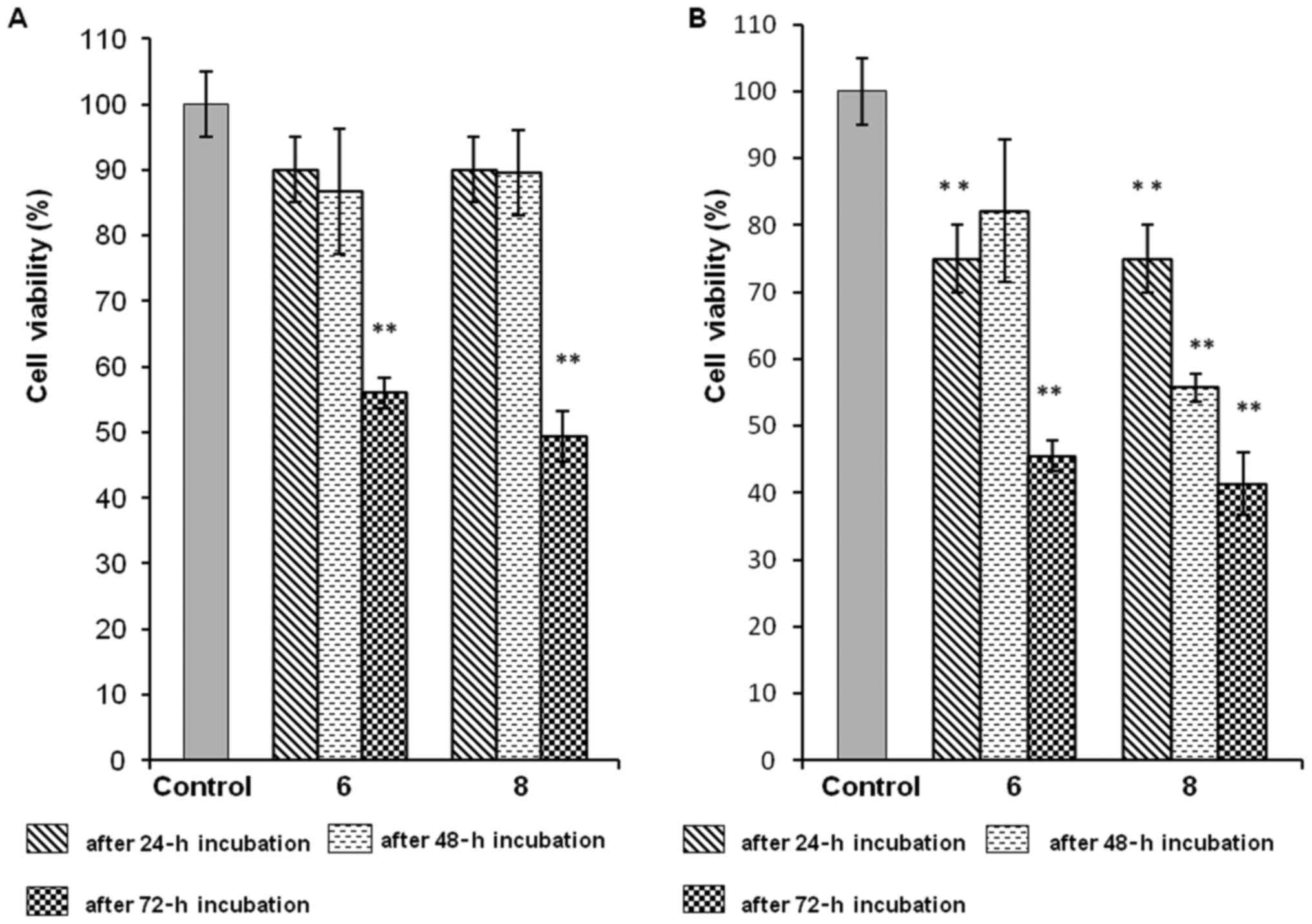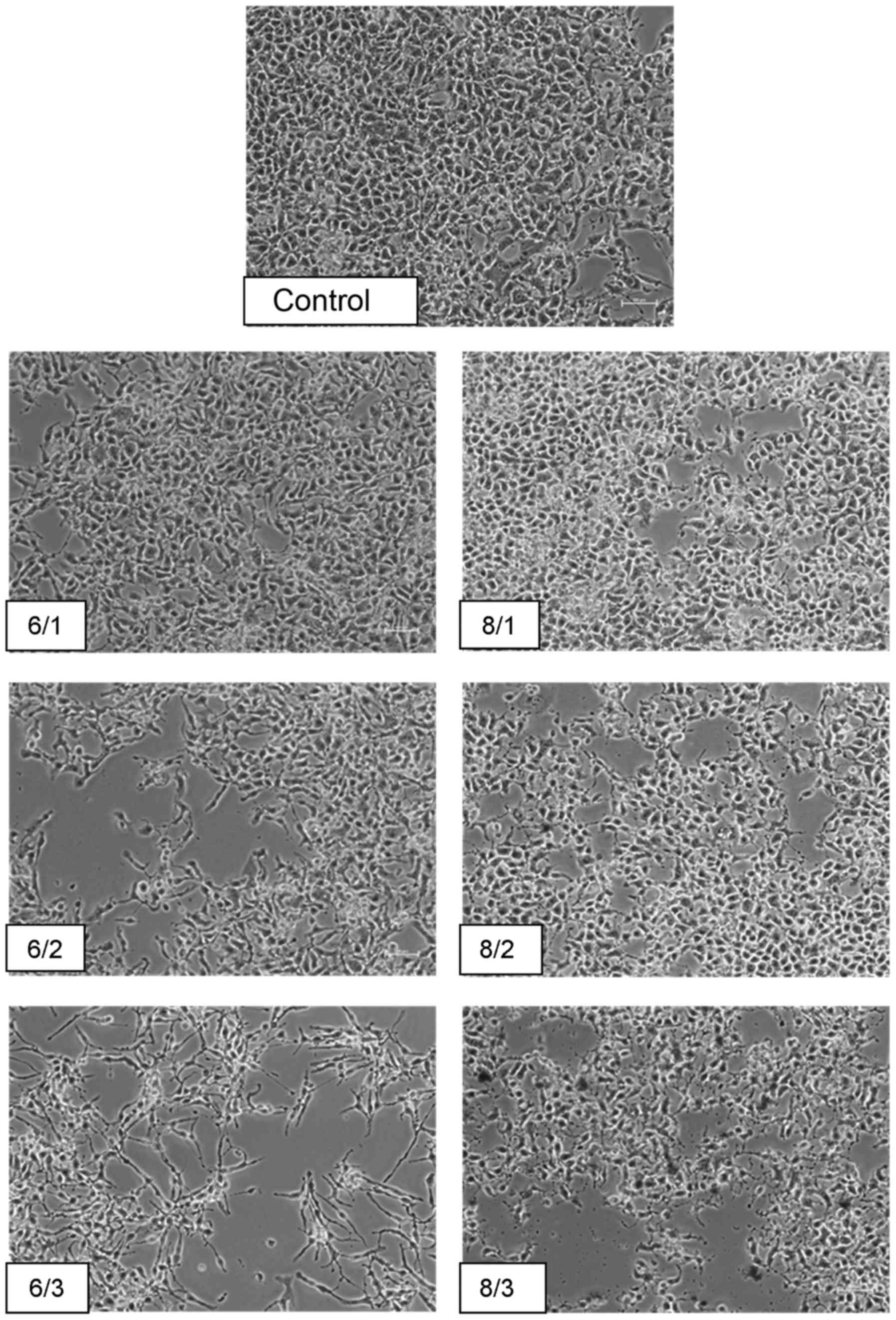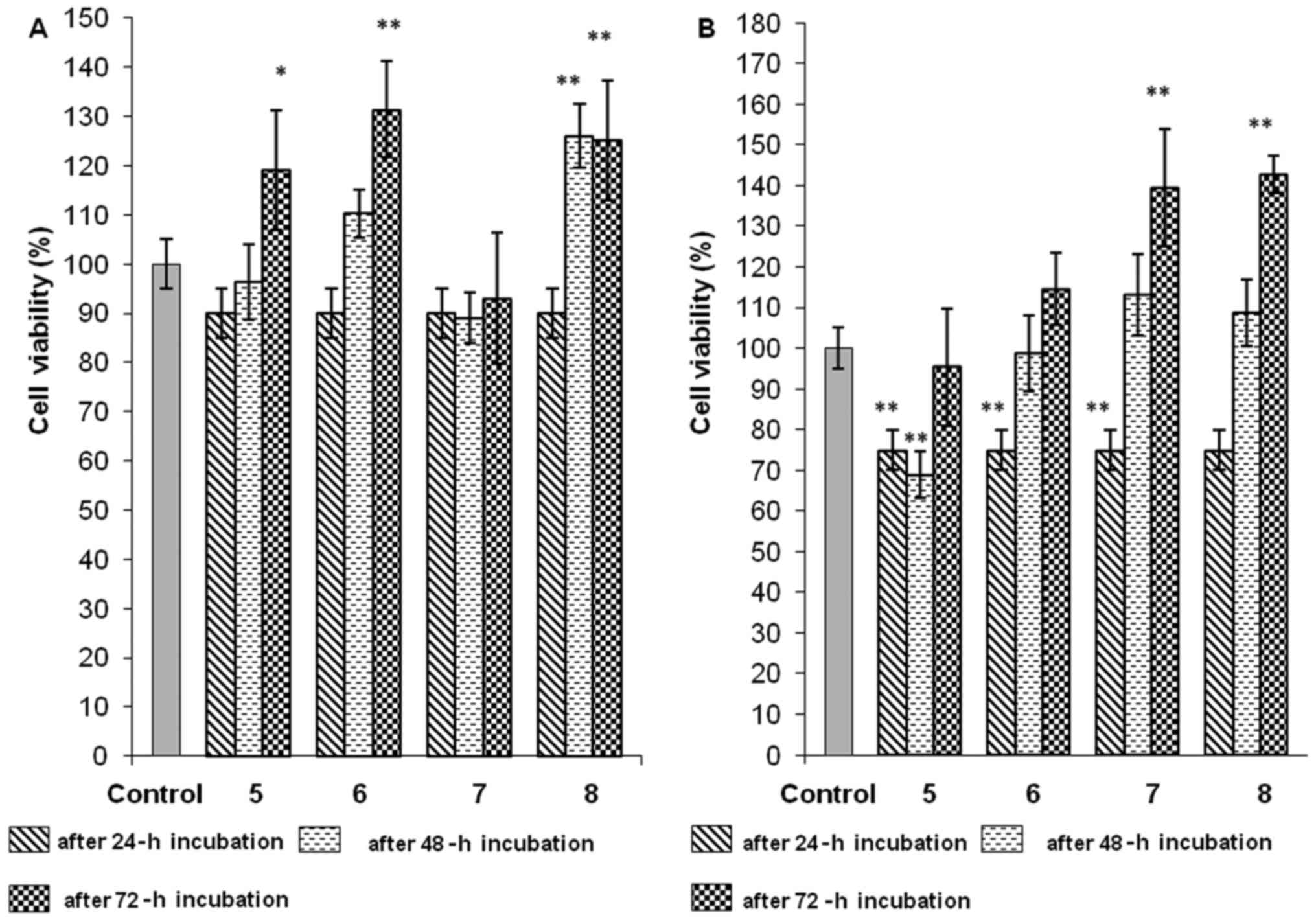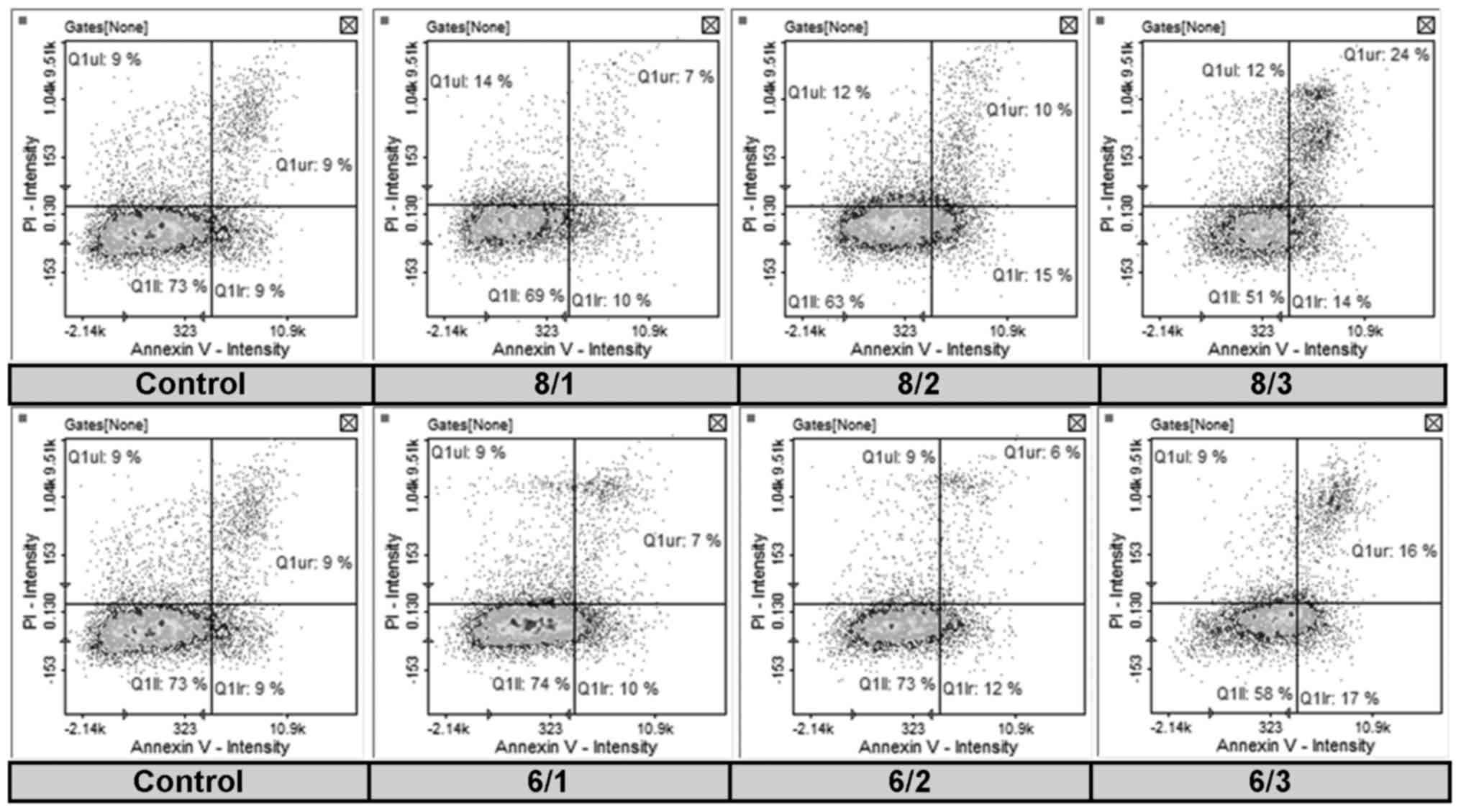|
1
|
Gregorić T, Sedić M, Grbčić P, Tomljenović
Paravić A, Kraljević Pavelić S, Cetina M, Vianello R and Raić-Malić
S: Novel pyrimidine-2,4-dione-1,2,3-triazole and
furo[2,3-d]pyrimidine-2-one-1,2,3-triazole hybrids as potential
anti-cancer agents: Synthesis, computational and X-ray analysis and
biological evaluation. Eur J Med Chem. 125:pp. 1247–1267. 2017,
View Article : Google Scholar : PubMed/NCBI
|
|
2
|
Escudier B, Porta C, Schmidinger M, Algaba
F, Patard JJ, Khoo V, Eisen T and Horwich A: ESMO Guidelines
Working Group: Renal cell carcinoma: ESMO Clinical Practice
Guidelines for diagnosis, treatment and follow-up. Ann Oncol.
25((Suppl 3)): iii49–iii56. 2014. View Article : Google Scholar : PubMed/NCBI
|
|
3
|
Meyers RL, Tiao G, de Ville de Goyet J,
Superina R and Aronson DC: Hepatoblastoma state of the art:
Pre-treatment extent of disease, surgical resection guidelines and
the role of liver transplantation. Curr Opin Pediatr. 26:29–36.
2014. View Article : Google Scholar : PubMed/NCBI
|
|
4
|
Sumazin P, Chen Y, Treviño LR, Sarabia SF,
Hampton OA, Patel K, Mistretta TA, Zorman B, Thompson P, Heczey A,
et al: Genomic analysis of hepatoblastoma identifies distinct
molecular and prognostic subgroups. Hepatology. 65:104–121. 2017.
View Article : Google Scholar : PubMed/NCBI
|
|
5
|
Ridge CA, Pua BB and Madoff DC:
Epidemiology and staging of renal cell carcinoma. Semin Intervent
Radiol. 31:3–8. 2014. View Article : Google Scholar : PubMed/NCBI
|
|
6
|
Stewart BW and Wild CP: World Cancer
Report. 2014, International Agency for Research on Cancer Lyon.
2014
|
|
7
|
Znaor A, Lortet-Tieulent J, Laversanne M,
Jemal A and Bray F: International variations and trends in renal
cell carcinoma incidence and mortality. Eur Urol. 67:519–530. 2015.
View Article : Google Scholar : PubMed/NCBI
|
|
8
|
Kabaria R, Klaassen Z and Terris MK: Renal
cell carcinoma: Links and risks. Int J Nephrol Renovasc Dis.
9:45–52. 2016.PubMed/NCBI
|
|
9
|
López-Terrada D, Cheung SW, Finegold MJ
and Knowles BB: Hep G2 is a hepatoblastoma-derived cell line. Hum
Pathol. 40:1512–1515. 2009. View Article : Google Scholar
|
|
10
|
Chen Z, Zhang J, Zhang Z, Feng Z, Wei J,
Lu J, Fang Y, Liang Y, Cen J, Pan Y, et al: The putative tumor
suppressor microRNA-30a-5p modulates clear cell renal cell
carcinoma aggressiveness through repression of ZEB2. Cell Death
Dis. 8:e28592017. View Article : Google Scholar : PubMed/NCBI
|
|
11
|
Chen T, Ji B and Chen Y: Tetrandrine
triggers apoptosis and cell cycle arrest in human renal cell
carcinoma cells. J Nat Med. 68:46–52. 2014. View Article : Google Scholar : PubMed/NCBI
|
|
12
|
Roseweir AK, Qayyum T, Lim Z, Hammond R,
MacDonald AI, Fraser S, Oades GM, Aitchison M, Jones RJ and Edwards
J: Nuclear expression of Lyn, a Src family kinase member, is
associated with poor prognosis in renal cancer patients. BMC
Cancer. 16:2292016. View Article : Google Scholar : PubMed/NCBI
|
|
13
|
Fang Y, Wei J, Cao J, Zhao H, Liao B, Qiu
S, Wang D, Luo J and Chen W: Protein expression of ZEB2 in renal
cell carcinoma and its prognostic significance in patient survival.
PLoS One. 8:e625582013. View Article : Google Scholar : PubMed/NCBI
|
|
14
|
Yuan ZX, Mo J, Zhao G, Shu G, Fu HL and
Zhao W: Targeting strategies for renal cell carcinoma: From renal
cancer cells to renal cancer stem cells. Front Pharmacol.
7:4232016. View Article : Google Scholar : PubMed/NCBI
|
|
15
|
Jain AK, Vaidya A, Ravichandran V, Kashaw
SK and Agrawal RK: Recent developments and biological activities of
thiazolidinone derivatives: A review. Bioorg Med Chem.
20:3378–3395. 2012. View Article : Google Scholar : PubMed/NCBI
|
|
16
|
Tripathi AC, Gupta SJ, Fatima GN, Sonar
PK, Verma A and Saraf SK: 4-Thiazolidinones: The advances
continue…. Eur J Med Chem. 72:52–77. 2014. View Article : Google Scholar : PubMed/NCBI
|
|
17
|
Murugesan V, Tiwari VS, Saxena R, Tripathi
R, Paranjape R, Kulkarni S, Makwana N, Suryawanshi R and Katti SB:
Lead optimization at C-2 and N-3 positions of thiazolidin-4-ones as
HIV-1 non-nucleoside reverse transcriptase inhibitors. Bioorg Med
Chem. 19:6919–6926. 2011. View Article : Google Scholar : PubMed/NCBI
|
|
18
|
Omar K, Geronikaki A, Zoumpoulakis P,
Camoutsis C, Soković M, Cirić A and Glamoclija J: Novel
4-thiazolidinone derivatives as potential antifungal and
antibacterial drugs. Bioorg Med Chem. 18:426–432. 2010. View Article : Google Scholar : PubMed/NCBI
|
|
19
|
Popiołek Ł, Stefańska J, Kiełczykowska M,
Musik I, Biernasiuk A, Malm A and Wujec M: Synthesis, dissociation
constants, and antimicrobial activity of novel
2,3-disubstituted-1,3-thiazolidin-4-one derivatives. J Chem. 53:pp.
393–402. 2016
|
|
20
|
Rawal RK, Tripathi R, Katti SB,
Pannecouque C and De Clercq E: Synthesis and evaluation of
2-(2,6-dihalophenyl)-3-pyrimidinyl-1,3-thiazolidin-4-one analogues
as anti-HIV-1 agents. Bioorg Med Chem. 15:pp. 3134–3142. 2007,
View Article : Google Scholar : PubMed/NCBI
|
|
21
|
Bielenica A, Szulczyk D, Olejarz W,
Madeddu S, Giliberti G, Materek IB, Koziol AE and Struga M:
1H-Tetrazol-5-amine and 1,3-thiazolidin-4-one derivatives
containing 3-(trifluoromethyl)phenyl scaffold: Synthesis, cytotoxic
and anti-HIV studies. Biomed Pharmacother. 94:pp. 804–812. 2017,
View Article : Google Scholar : PubMed/NCBI
|
|
22
|
Archana, Srivastava VK and Kumar A:
Synthesis of newer thiadiazolyl and thiazolidinonyl quinazolin-4
3H-ones as potential anticonvulsant agents. Eur J Med Chem. 37:pp.
873–882. 2002, View Article : Google Scholar : PubMed/NCBI
|
|
23
|
Diurno MV, Mazzoni O, Correale G, Gomez
Monterrey I, Calignano A, La Rana G and Bolognese A: Synthesis and
structure-activity relationships of 2-(substituted
phenyl)-3-[3-(N,N-dimethylamino)propyl]-1,3-thiazolidin-4-ones
acting as H1-histamine antagonists. Farmaco. 54:pp. 579–583. 1999,
View Article : Google Scholar : PubMed/NCBI
|
|
24
|
Firke SD, Firake BM, Chaudhari RY and
Patil R: Synthetic and pharmacological evaluation of some pyridine
containing thiazolidinones. Asian J Res Chem. 2:157–161. 2009.
|
|
25
|
Popiołek Ł, Biernasiuk A and Malm A:
Synthesis and antimicrobial activity of new 1,3-thiazolidin-4-one
derivatives obtained from carboxylic acid hydrazides. Phosphorus
Sulfur. 190:pp. 251–260. 2015, View Article : Google Scholar
|
|
26
|
Wang S, Zhao Y, Zhang G, Lv Y, Zhang N and
Gong P: Design, synthesis and biological evaluation of novel
4-thiazolidinones containing indolin-2-one moiety as potential
antitumor agent. Eur J Med Chem. 46:pp. 3509–3518. 2011, View Article : Google Scholar : PubMed/NCBI
|
|
27
|
Zhou H, Wu S, Zhai S, Liu A, Sun Y, Li R,
Zhang Y, Ekins S, Swaan PW, Fang B, et al: Design, synthesis,
cytoselective toxicity, structure-activity relationships, and
pharmacophore of thiazolidinone derivatives targeting
drug-resistant lung cancer cells. J Med Chem. 51:pp. 1242–1251.
2008, View Article : Google Scholar : PubMed/NCBI
|
|
28
|
Sharath Kumar KS, Hanumappa A, Vetrivel M,
Hegde M, Girish YR, Byregowda TR, Rao S, Raghavan SC and Rangappa
KS: Antiproliferative and tumor inhibitory studies of 2,3
disubstituted 4-thiazolidinone derivatives. Bioorg Med Chem Lett.
25:3616–3620. 2015. View Article : Google Scholar : PubMed/NCBI
|
|
29
|
Wang S, Zhao Y, Zhu W, Liu Y, Guo K and
Gong P: Synthesis and anticancer activity of Indolin-2-one
derivatives bearing the 4-thiazolidinone moiety. Arch Pharm
(Weinheim). 345:pp. 73–80. 2012, View Article : Google Scholar : PubMed/NCBI
|
|
30
|
Joseph A, Shah CS, Kumar SS, Alex AT,
Maliyakkal N, Moorkoth S and Mathew JE: Synthesis, in vitro
anticancer and antioxidant activity of thiadiazole substituted
thiazolidin-4-ones. Acta Pharm. 63:pp. 397–408. 2013, View Article : Google Scholar : PubMed/NCBI
|
|
31
|
Ottanà R, Carotti S, Maccari R, Landini I,
Chiricosta G, Caciagli B, Vigorita MG and Mini E: In vitro
antiproliferative activity against human colon cancer cell lines of
representative 4-thiazolidinones. Part I. Bioorg Med Chem Lett.
15:3930–3933. 2005. View Article : Google Scholar : PubMed/NCBI
|
|
32
|
George RF: Stereoselective synthesis and
QSAR study of cytotoxic
2-(4-oxo-thiazolidin-2-ylidene)-2-cyano-N-arylacetamides. Eur J Med
Chem. 47:pp. 377–386. 2012, View Article : Google Scholar : PubMed/NCBI
|
|
33
|
Živković MB, Matić IZ, Rodić MV, Novaković
IT, Krivokuća AM, Sladić DM and Krstić NM: Anticancer potential of
new steroidal thiazolidin-4-one derivatives. Mechanisms of
cytotoxic action and effects on angiogenesis in vitro. J Steroid
Biochem Mol Biol. 174:72–85. 2017. View Article : Google Scholar : PubMed/NCBI
|
|
34
|
Suthar SK, Jaiswal V, Lohan S, Bansal S,
Chaudhary A, Tiwari A, Alex AT and Joesph A: Novel quinolone
substituted thiazolidin-4-ones as anti-inflammatory, anticancer
agents: Design, synthesis and biological screening. Eur J Med Chem.
63:pp. 589–602. 2013, View Article : Google Scholar : PubMed/NCBI
|
|
35
|
Kunzler A, Neuenfeldt PD, das Neves AM,
Pereira CM, Marques GH, Nascente PS, Fernandes MH, Hübner SO and
Cunico W: Synthesis, antifungal and cytotoxic activities of
2-aryl-3-((piperidin-1-yl)ethyl)thiazolidinones. Eur J Med Chem.
64:pp. 74–80. 2013, View Article : Google Scholar : PubMed/NCBI
|
|
36
|
Zou Y, Wang J, Leng X, Huang J, Xue W,
Zhang J and Huang Y: The selective MEK1 inhibitor Selumetinib
enhances the antitumor activity of everolimus against renal cell
carcinoma in vitro and in vivo. Oncotarget. 8:20825–20833. 2017.
View Article : Google Scholar : PubMed/NCBI
|
|
37
|
Wang Y, Xia C, Lun Z, Lv Y, Chen W and Li
T: Crosstalk between p38 MAPK and caspase-9 regulates
mitochondria-mediated apoptosis induced by
tetra-α-(4-carboxyphenoxy) phthalocyanine zinc photodynamic therapy
in LoVo cells. Oncol Rep. 39:61–70. 2018.PubMed/NCBI
|















